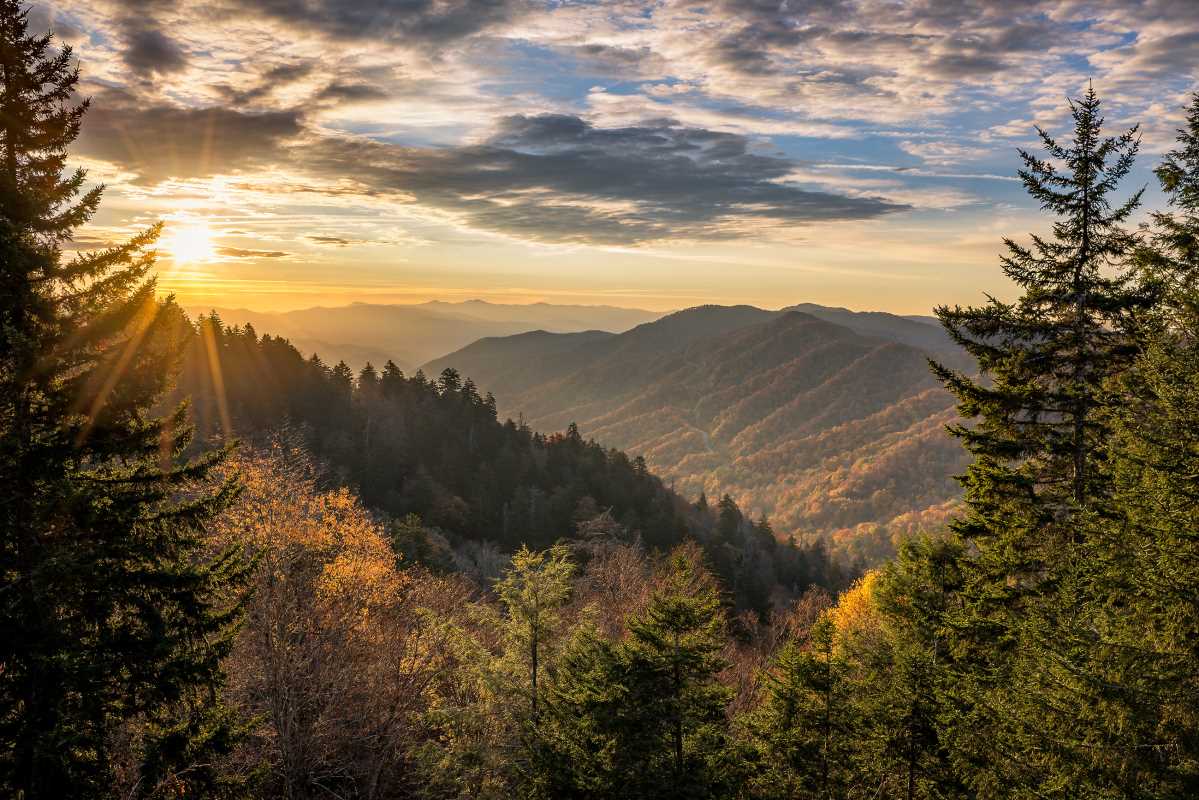There's a special kind of magic that settles over the Great Smoky Mountains each autumn. The air turns crisp, the scent of woodsmoke hangs faintly in the valleys, and the rolling hills erupt into a symphony of red, orange, and gold. It's a time when this ancient landscape, known for its signature blue haze, puts on its most brilliant show, drawing visitors from all over to witness the breathtaking transformation.
Why the Smokies Shine in the Fall
What makes the fall foliage in Great Smoky Mountains National Park so spectacular? The answer lies in the park's incredible biodiversity. With over 100 species of native trees, including sugar maples, scarlet oaks, hickories, and sweetgums, the Smokies produce one of the most varied and long-lasting autumn color displays in the world.
The timing of the color change is a fascinating dance between elevation and temperature. The show starts at the highest elevations in mid-to-late September, with the brilliant yellows of American beeches and yellow birches. As October progresses, the wave of color slowly rolls down the mountainsides. The peak for mid and lower elevations, where you'll find the most vibrant reds from maple and oak trees, typically happens from mid-October to early November. This staggered schedule means you have a wide window to catch the phenomenal colors somewhere in the park.
Best Hikes to Experience the Autumn Spectacle
Hiking is, without a doubt, the best way to immerse yourself in the fall beauty of the Smokies. The trails offer everything from quiet walks through golden forests to challenging climbs with panoramic, color-drenched views.
Alum Cave Trail to Mount LeConte
- Difficulty: Strenuous
- Length: 11 miles roundtrip to the summit
This is one of the most iconic and rewarding hikes in the park. While the full trek to the summit of Mount LeConte is a serious undertaking, you don't have to go the whole way to experience incredible fall scenery. The first 2.3 miles to Alum Cave Bluffs is a popular and moderately difficult option. You'll cross log bridges over gurgling streams and walk through Arch Rock, a natural stone archway. The trail is lined with trees that turn brilliant shades, and the views from the bluffs are stunning. For those who press on, the higher elevations offer a different palette of colors and a true sense of accomplishment.
Clingmans Dome Observation Tower
- Difficulty: Easy to Moderate
- Length: 1 mile roundtrip
For one of the most accessible and jaw-dropping views, head to Clingmans Dome. At 6,643 feet, it's the highest point in the Smoky Mountains. A steep, 0.5-mile paved path leads to the futuristic observation tower, where you'll be rewarded with 360-degree panoramic views of the mountains ablaze in fall color. On a clear day, you can see for over 100 miles. Because of its high elevation, this is one of the first places in the park to see fall color, often peaking in early October. Be sure to bring a jacket, as it can be 10-20 degrees cooler than in the valleys.
Forney Ridge Trail to Andrews Bald
- Difficulty: Moderate
- Length: 3.6 miles roundtrip
Starting from the Clingmans Dome parking lot, this trail offers a completely different experience. Instead of climbing, you'll descend through a beautiful, high-elevation spruce-fir forest. The trail opens up onto Andrews Bald, a large grassy meadow on the mountainside. It's the perfect spot for a picnic, surrounded by stunning views of the North Carolina Smokies. The contrast between the green grass of the bald and the fiery colors of the surrounding landscape is absolutely unforgettable.
The Oconaluftee River Trail
- Difficulty: Easy
- Length: 3 miles roundtrip
If you're looking for a relaxing, flat walk, the Oconaluftee River Trail is a perfect choice. It's one of only two trails in the park that allows dogs and bicycles. The path follows the gentle Oconaluftee River, with the trail shaded by trees turning brilliant shades of yellow and orange. The colors reflecting in the calm water create beautiful photo opportunities. It's also a great place to spot elk, which often graze in the fields near the Oconaluftee Visitor Center, especially in the early morning and late afternoon.
Porters Creek Trail
- Difficulty: Easy to Moderate
- Length: 4 miles roundtrip
Located in the less-crowded Greenbrier section of the park, this trail is a local favorite in the fall. The first mile is an old gravel road that winds through a magnificent, mossy forest alongside the creek. You'll pass by historic farmstead remnants, including old stone walls and a cantilevered barn. The trail is known for its towering tulip poplars, which turn a stunning, uniform yellow in the fall, creating a golden canopy overhead. It’s a peaceful hike that feels like a walk back in time.
Tips for Planning Your Autumn Visit
Fall is the busiest season in the Smoky Mountains, but with a bit of planning, you can navigate the crowds and make the most of your trip.
Time Your Visit Wisely
While peak color is hard to predict exactly, the second half of October is generally a safe bet for seeing great color at the mid-elevations where most visitors spend their time. To track the progress, check online "fall foliage predictors" and look at recent photos on social media from the park's location tags. If you can, plan a weekday visit. Weekends, especially in October, bring heavy traffic and crowded trails.
Start Your Day Early
This is the golden rule for visiting the Smokies in the fall. To get a parking spot at popular trailheads like Alum Cave or Clingmans Dome, you need to arrive early—and we mean early (before 8 a.m. on a weekday, and even earlier on a weekend). An early start also means you'll enjoy the trails with fewer people and better light for photos. The same goes for driving scenic routes like the Cades Cove Loop Road; go early to avoid getting stuck in a long line of cars.
Explore Beyond the Main Drags
The main roads like the Cades Cove loop and Newfound Gap Road can become incredibly congested. Don't be afraid to explore lesser-known areas of the park. The Greenbrier, Cosby, and Cataloochee valleys offer beautiful scenery and historic buildings with a fraction of the crowds. Driving the Roaring Fork Motor Nature Trail just outside of Gatlinburg is another fantastic option for a scenic drive with access to great trails.
Dress in Layers
Mountain weather is famously fickle, especially in the fall. A day can start out cold and foggy, become warm and sunny by noon, and then turn chilly again as evening approaches. Dressing in layers—a base layer, a fleece or mid-layer, and a waterproof outer shell—allows you to adjust to the changing conditions and stay comfortable all day.
Book Accommodations Far in Advance
If you plan to stay in or near the park in towns like Gatlinburg, Pigeon Forge, or Townsend, book your hotel, cabin, or campsite months in advance. Accommodations fill up very quickly for the fall season.
The allure of the Smoky Mountains in autumn is undeniable. It's a time of vibrant celebration, as nature puts on one last, glorious display before the quiet of winter. Whether you're taking a leisurely stroll by a river or challenging yourself on a mountain summit, the experience of being surrounded by such intense, fleeting beauty is profoundly moving. The crisp air, the colorful leaves crunching underfoot, and the epic views combine to create memories that will warm you long after the last leaf has fallen.
.jpg)






.jpg)